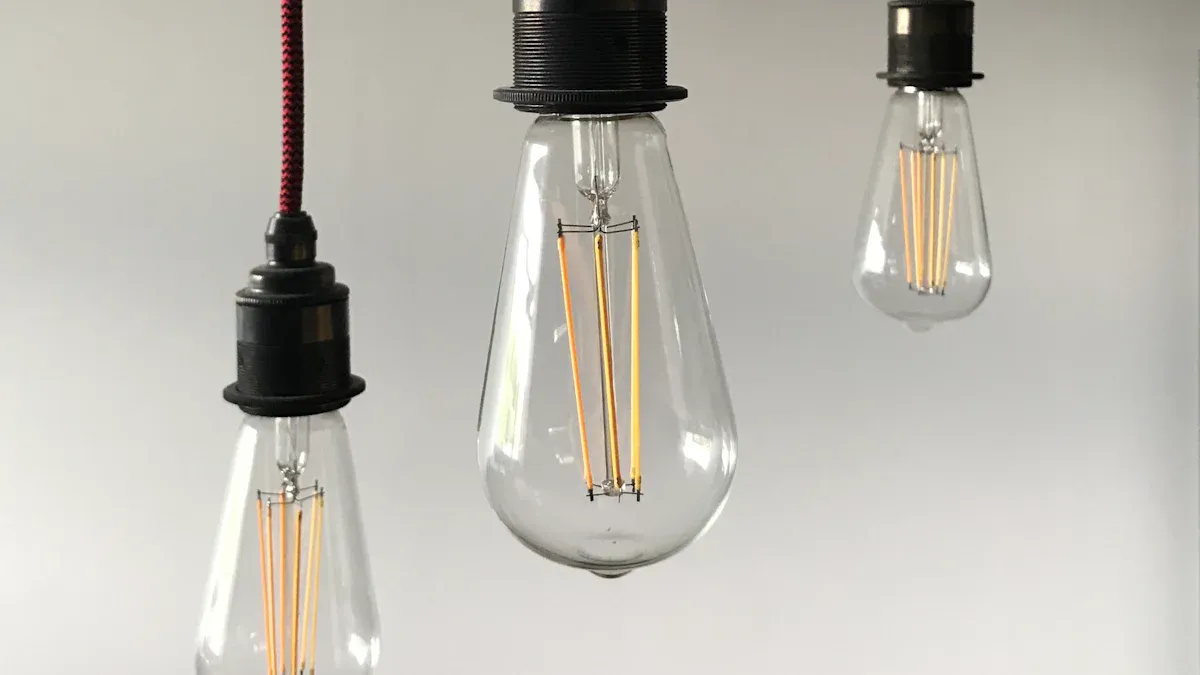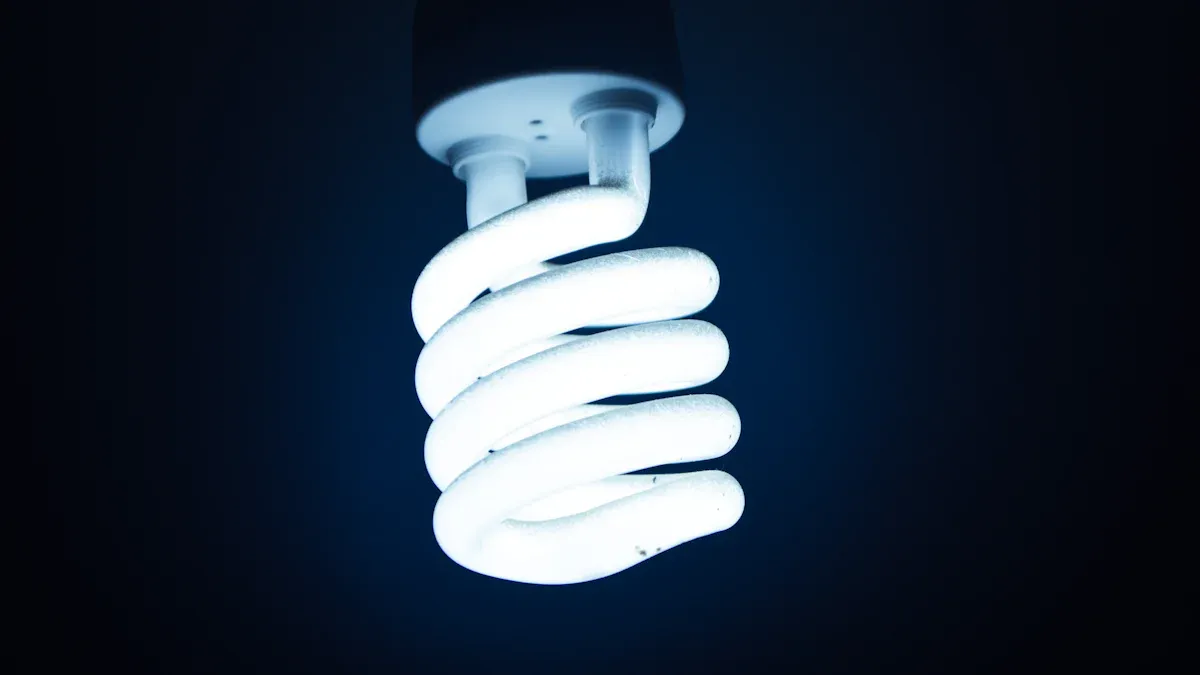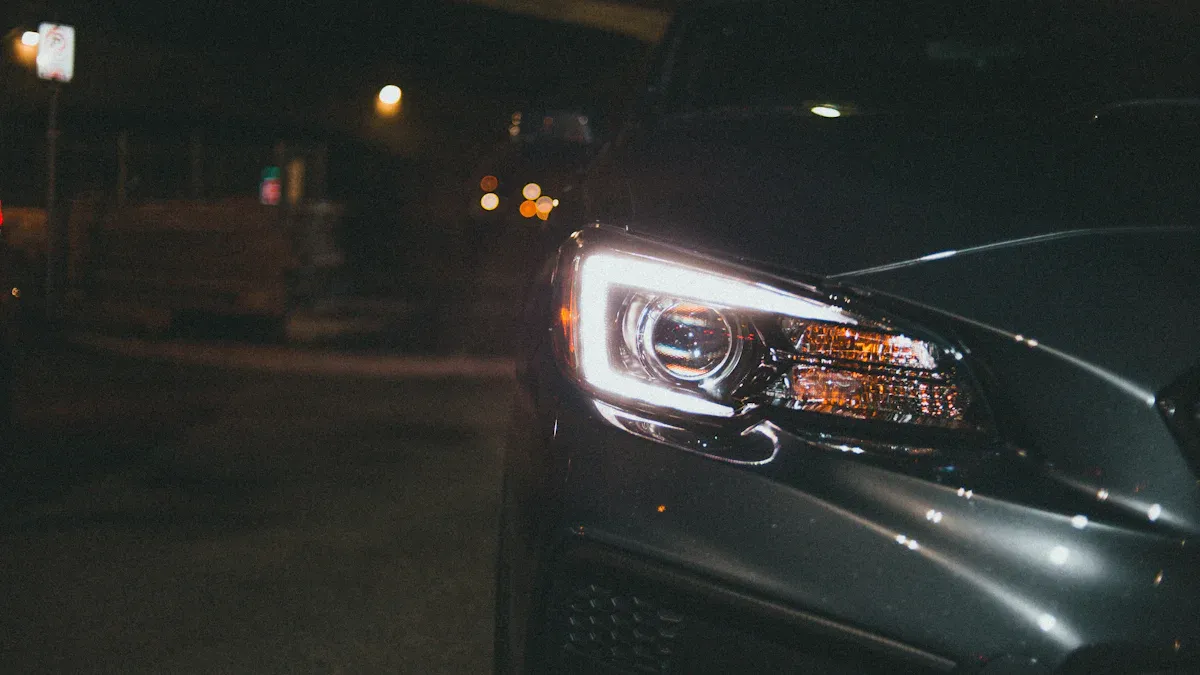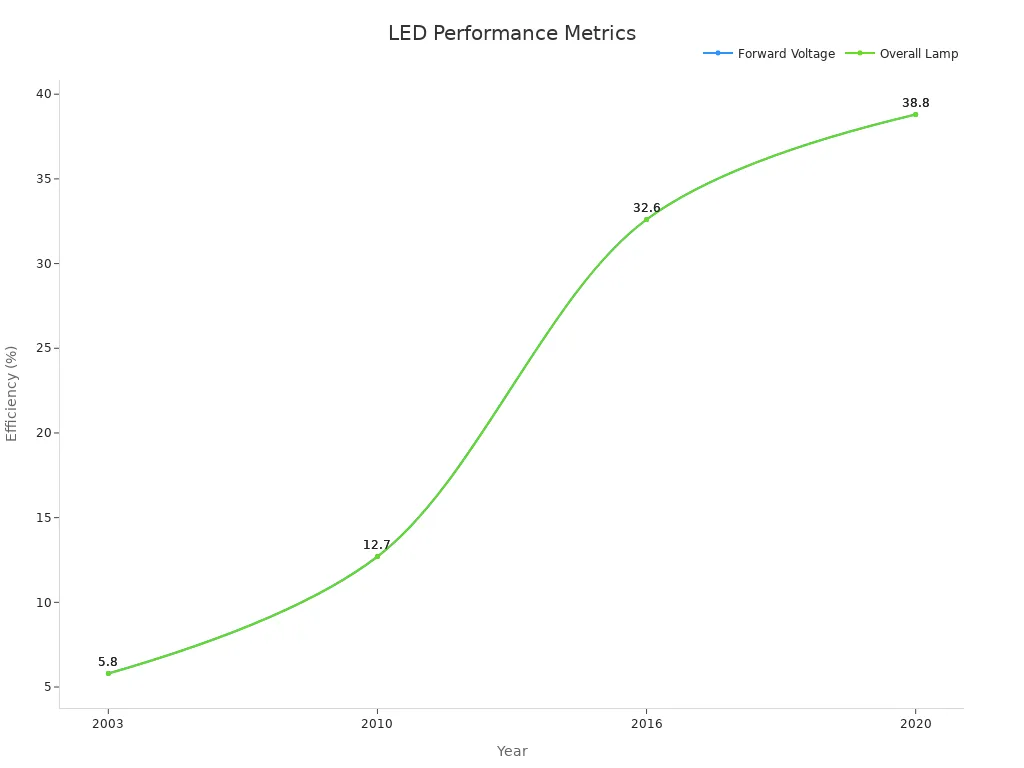Halogen vs LED Bulbs

When selecting lights for your home, it’s crucial to understand the differences between halogen vs LED bulbs. Halogen bulbs utilize a tungsten wire to produce light, offering a warm glow but consuming more energy. In contrast, LED lights employ semiconductors to generate bright illumination while being energy-efficient.
An increasing number of people now favor LED lights due to their superior performance and longevity. For instance:
LED bulbs can last up to 25,000 hours, whereas halogen bulbs typically last only 2,000 to 4,000 hours.
LEDs operate at cooler temperatures, making them safer for use in the home.
The availability of affordable LED products, such as a $4.95 bulb, has led to a remarkable 500% increase in sales.
This shift highlights the importance of comparing halogen vs LED bulbs before making a decision about your lighting options. For more information, feel free to check our About Us page.
Key Takeaways
LED bulbs last much longer than halogen bulbs. LEDs can work for up to 50,000 hours, while halogens only last 2,000-4,000 hours.
Using LED bulbs helps save money on electricity. They use up to 80% less energy than halogen bulbs.
LEDs stay cooler when they are on. This makes them safer to use at home and lowers the chance of burns or fires.
LED bulbs cost more at first but save money later. Their long life and energy savings make them a smart choice.
When switching from halogen to LED bulbs, check if they fit your fixtures. This prevents problems like flickering or getting too hot.
What Are Halogen Bulbs?

Halogen bulbs are a type of incandescent light that uses halogen gas. They give off bright, natural light and are small in size. This makes them a popular choice for many uses. Knowing how they work and where they are used can help you decide if they suit your needs.
How Halogen Bulbs Work
Halogen bulbs light up when electricity flows through a tungsten wire. The wire heats up and glows to produce light. Halogen gas, like iodine or bromine, helps the bulb last longer. It also keeps the light bright by returning evaporated tungsten to the wire.
Here are some main features of halogen bulbs:
Key Features | Details |
|---|---|
Peak Wavelength | 1000 nm |
Power Drift per Hour | 0.01% |
Color Temperature Range | ±15 K |
Feature | Information |
|---|---|
Bulb Type | Quartz Tungsten-Halogen |
Wavelength Range | 360 - 2600 nm |
Color Temperature | 2796 K |
Power Usage | 9 W |
Power Stability | <0.05% |
Average Lifespan | 10,000 Hours |
Heat Risks | Can get very hot; avoid touching. |
UV Radiation | Can harm skin and eyes; stay safe. |
Ozone Emissions | May create ozone; ensure airflow. |
Halogen bulbs give great light but have some risks. They can get very hot, emit UV rays, and produce ozone. Always handle them with care and follow safety rules.
Common Uses of Halogen Bulbs
Halogen bulbs are useful in many places. Their bright light works well in homes and businesses. You’ll see them in houses, offices, and public areas. They are also common in car headlights because they are bright and affordable.
Here are some typical uses:
Use Area | Description |
|---|---|
Cars | Used in headlights and inside vehicles. |
Homes | Popular for their warm, bright light and style. |
Workplaces | Needed for strong lighting in offices and public spaces. |
Special Uses | Found in stage lights, medical tools, and photo studios. |
Cars often use halogen bulbs because they are cheap and work well.
In homes, they create a cozy and welcoming feel.
Special uses, like stage lighting, need their brightness and accuracy.
Halogen bulbs are still a good option for many needs. But their high energy use and heat may not fit all modern uses.
What Are LED Bulbs?

LED bulbs are a new way to light up spaces. They use advanced technology to give bright light and save energy. They also last much longer than older bulbs.
How LED Bulbs Work
LED stands for Light Emitting Diode. These bulbs make light using a semiconductor. When electricity passes through, it creates light by releasing photons. This process wastes less energy as heat. Unlike halogen or incandescent bulbs, LEDs turn on right away and stay bright over time.
Here are some key features of LED bulbs:
Feature | Details |
|---|---|
Brightness | As bright or brighter than other bulbs, spreads evenly. |
Lifespan | Lasts 35,000 hours or more, about 15 years with daily use. |
Efficiency | Uses less energy than fluorescent lights. |
Power Factor | At least 0.7 for bulbs over 5 watts. |
Instant On | Lights up immediately when switched on. |
Dimming Capability | Can dim without changing color, but needs special dimmers. |
Off-State Power Draw | No power used when off, except for controls under 0.5 watts. |
Color Quality | Gives steady, high-quality white light over time. |
LEDs have improved a lot over the years. For example, their efficiency grew from 5.8% in 2003 to 38.8% in 2020. This makes them a top choice for homes and businesses.

Common Applications of LED Bulbs
LED bulbs are used in many places because they save energy and last long. By 2019, they made up 50% of global light sales. By 2030, they may reach 87%.
Here are some common uses:
Residential Lighting: Great for home lights and decorations. They are bright and save money on bills.
Commercial Spaces: Offices and stores use LEDs to cut energy costs. Though they use fewer lights, they save a lot of electricity.
Outdoor Lighting: Perfect for streetlights, gardens, and floodlights. They are strong and handle bad weather well.
Specialized Uses: Found in car lights, medical tools, and even plant-growing lights.
Switching to LEDs saves energy, lowers costs, and gives reliable light for years.
Pros and Cons of Halogen Bulbs
Advantages of Halogen Bulbs
Halogen bulbs have many benefits for specific lighting needs. They give off bright, natural light, which is great for clear and accurate colors. This makes them useful in places like photo studios or stage lighting. Halogen bulbs last longer than regular incandescent bulbs, usually between 2,000 and 5,000 hours. They also use less energy than standard incandescent bulbs but still perform better.
Feature | Halogen Bulbs | Standard Incandescent Bulbs |
|---|---|---|
Light Output | 20–40a-index (80-100) | Lower than halogen |
Lifespan | 2,000 to 5,000 hours | Shorter lifespan |
Efficiency | About twice as efficient | Less efficient |
Another plus is their small size, which fits into tight spaces. This makes them handy for homes, offices, and cars. Halogen bulbs can also dim, letting you adjust the brightness as needed. They are cheaper than LED bulbs, making them a good choice for people on a budget.
Tip: Choose halogen bulbs if you want warm, bright light for decorative fixtures.
Disadvantages of Halogen Bulbs
Halogen bulbs also have some downsides. They use more energy than LED or CFL bulbs, even though they are better than incandescent ones. For example, halogen bulbs save 25% to 30% more energy than incandescent bulbs but are still less efficient than LEDs.
Feature | Halogen Bulbs | Incandescent Bulbs | LED/CFL Bulbs |
|---|---|---|---|
Power Consumption | 25% to 30% less than incandescent | Baseline (100%) | More efficient than halogen |
Lifespan | ~2,500 hours | ~1,000 hours | 15,000+ hours |
Heat Generation | Higher than LED/CFL | High | Lower than halogen |
Cost | More expensive | Less expensive | Varies, often more expensive |
Environmental Impact | Less eco-friendly than LEDs | Less eco-friendly | More eco-friendly |
They also get very hot, which can be dangerous. The heat can cause burns or even fires if not handled carefully. Halogen bulbs are less eco-friendly than LEDs because they use more energy and don’t last as long. Replacing them often can cost more money and create more waste.
Note: If you want to save energy and money over time, halogen bulbs might not be the best choice.
Pros and Cons of LED Bulbs
Advantages of LED Bulbs
LED bulbs have many benefits, making them a top choice today. They use energy very efficiently, producing 37 to 120 lumens per watt. This is much better than incandescent bulbs, which only produce about 10 lumens per watt. Using LEDs can lower electricity use by up to 6.99%. This means you’ll save money on energy bills and help the environment.
Another big advantage is how long they last. LED bulbs can work for 25,000 to 50,000 hours. This is much longer than halogen or incandescent bulbs. You won’t need to replace them often, saving money on new bulbs. LEDs also stay cool because 90% of their energy becomes light, not heat. This makes them safer and great for places with heat-sensitive items.
LEDs are also very strong and durable. They can handle shocks and vibrations, so they’re good for outdoor use or areas with lots of movement. They work well in extreme temperatures, from -40°C to 100°C. These features make LEDs useful for homes, businesses, and even factories.
Tip: Choose LEDs if you want lighting that saves energy and lasts a long time.
Disadvantages of LED Bulbs
LED bulbs do have some downsides to think about. They cost more upfront than other bulbs. A 100W LED bulb can cost $10 to $20, while halogen or incandescent bulbs cost $1 to $7. Even though LEDs save money over time, the initial price might seem high.
Heat can also be an issue. While LEDs don’t get very hot, poor heat management can shorten their life. This is a problem in closed fixtures or places with bad airflow. To get the most out of LEDs, make sure they are installed properly with good ventilation.
Some LEDs may not show colors as accurately. This is due to lower Color Rendering Index (CRI) values. This can be a problem in places like art galleries or stores where color matters. If color accuracy is important, look for LEDs with high CRI ratings.
Note: LEDs are efficient and long-lasting, but their higher cost and heat concerns need attention.
Can Halogen Bulbs Be Replaced with LED Bulbs?
Switching from halogen to LED bulbs is a smart choice. It helps save energy and lowers costs. But, you need to check a few things first. This section explains what to check and how to install LED bulbs properly.
Compatibility Factors
Replacing halogen bulbs with LEDs isn’t always simple. You must ensure your setup works with the new bulbs. Here are the main things to check:
Voltage Needs: Make sure the LED bulbs match your system’s voltage. Most systems use 12V or 24V. Using the wrong voltage can harm the bulb or fixture.
Transformer Fit: If your system has a transformer, check if it supports LED bulbs. Some transformers for halogen bulbs may not work with LEDs.
Wiring and Connectors: Look at the wiring and connectors in your fixtures. Older setups might need updates to safely use LED bulbs.
Checking these factors prevents problems like flickering or bulb failure. It ensures a smooth switch to LED lighting.
Installation Tips
After confirming compatibility, install the bulbs correctly for the best results. Follow these tips:
When replacing halogen bulbs with LEDs, use bulbs rated for enclosed fixtures. Without this, they may overheat and flicker or dim. Many LED bulbs have safety features to prevent overheating, but good airflow is still important.
Pick the Right Bulbs: Choose bulbs labeled "retrofit" or "direct replacement" for halogen bulbs.
Allow Airflow: While LEDs produce less heat, they still need ventilation. Avoid using them in tight fixtures unless rated for it.
Test After Installing: Once installed, test the bulb to ensure it works well. Flickering or dimming may mean a compatibility or setup issue.
By following these steps, you’ll enjoy the benefits of LED lighting. Proper installation makes bulbs last longer and work better.
Cost, Efficiency, and Lifespan: LED vs Halogen
Upfront Costs
Halogen bulbs cost less at first. They are about $3 each. LED bulbs, however, cost between $10 and $15. But over time, LEDs save more money. One LED bulb lasts as long as 10 halogen bulbs. This means buying 10 halogen bulbs costs more in the long run.
The LED market is growing fast because of these savings. By 2030, it may reach $192.68 billion. People are choosing LEDs for their long-term benefits. Even though LEDs cost more upfront, they last longer and save energy, making them a better choice.
Energy Efficiency
LED bulbs use much less energy than halogen bulbs. To make 800 lumens of light, a halogen bulb needs 50 watts. An LED bulb only needs 8.5 watts. This makes LEDs six times more efficient. LEDs also use 85% less energy than halogens. For example, running a 75-watt halogen bulb costs $23 a year. An LED version costs just $6, saving $17 per bulb annually.
LEDs turn electricity into light very efficiently. They waste little energy, which helps the environment. Switching to LEDs lowers your energy bills and reduces your carbon footprint.
Lifespan and Maintenance
LED bulbs last much longer than halogen bulbs. Halogen bulbs work for about 2,500 hours. LEDs can last over 30,000 hours. This means you’ll replace halogen bulbs more often, which adds to maintenance costs.
LEDs are also tougher and need less care. They handle shocks, vibrations, and extreme temperatures well. This makes them great for many places. With LEDs, you get dependable lighting for years without frequent replacements, saving time and money.
Tip: Want long-lasting, low-maintenance lighting? Choose LEDs for better results.
Which Is Better for Specific Applications?
Halogen Headlights vs LED Headlights
Choosing between halogen and LED headlights depends on your needs. Halogen headlights have been common for years. They give off a yellowish light and are cheap to replace. But they use more energy and don’t last as long as LEDs.
LED headlights provide bright white light, improving night visibility. They use 80% less energy and last up to ten times longer. This means fewer replacements and lower upkeep costs. Many LED headlights also include advanced features like adaptive beams that adjust to driving conditions.
Here’s a simple comparison:
Feature | Halogen Headlights | LED Headlights |
|---|---|---|
Brightness | Less bright | Very bright |
Power Usage | Uses more energy | Much more efficient |
Lifespan | Shorter | Up to 10x longer |
Replacement Cost | Low | Higher |
Light Quality | Yellowish | Bright white |
Advanced Features | None | Adaptive lighting available |
Efficiency Impact | Higher energy use | Improves fuel efficiency |
Tip: For better visibility and savings, pick LED headlights. If budget is tight, halogen headlights can still work.
Outdoor Lighting: LED vs Halogen
Outdoor lighting is important for safety and looks. Comparing LEDs and halogen bulbs for outdoor use shows LEDs are better in many ways.
LEDs use 80% less energy than halogen bulbs, saving money. They also last much longer—up to 40,000 hours compared to halogen’s 2,000–4,000 hours. This means fewer replacements and lower costs.
LEDs match halogen brightness but need less power. For example, an LED floodlight lights as well as a halogen one but uses less energy. LEDs are also tougher and handle bad weather, making them great for outdoor spaces.
Energy Efficiency: LEDs save 80% more energy than halogens.
Lifespan: LEDs last up to 40,000 hours; halogens last 2,000–4,000 hours.
Durability: LEDs resist harsh weather and vibrations better.
Note: For outdoor lighting, LEDs are the best choice. They save energy, last longer, and work well in all weather.
Indoor Lighting: LED vs Halogen
For indoor lighting, your choice depends on what you need. Halogen bulbs give warm, natural light, creating a cozy feel. They can dim, making them good for decorative or mood lighting. But they use more energy and produce more heat, which can raise cooling costs.
LED bulbs are energy-efficient and flexible. They come in different color tones, from warm to cool, for various rooms. LEDs stay cool, making them safer and more comfortable indoors. Their long life means fewer replacements, which is helpful for hard-to-reach fixtures.
If you want to save money and help the environment, choose LEDs. But if you like the warm glow of traditional bulbs and don’t mind higher energy costs, halogens might suit you.
Tip: Use LEDs for general lighting and halogens for accents or decor to enjoy both benefits.
When looking at halogen and LED bulbs, the differences are clear. Halogen bulbs use tungsten wires, get hotter, and need more energy. On the other hand, LED bulbs use semiconductors, save energy, stay cooler, and last longer. These features make LEDs a smarter and more cost-saving option over time.
Feature | LED Work Lights | Halogen Lighting |
|---|---|---|
Energy Efficiency | Uses less power, very efficient | Uses more power, less efficient |
Heat Emission | Stays cool, low heat | Gets very hot, high heat |
Lifespan | Lasts up to 50,000 hours | Lasts 2,000–5,000 hours |
Cost Analysis | Costs more upfront, saves money later | Costs less upfront, costs more later |
Pick the bulb that fits your needs best. LEDs are great for saving energy and lasting longer. But halogen bulbs might work better for decorative or cheaper setups. In the end, LEDs are safer, greener, and save more money.
FAQ
Why are LED bulbs better at saving energy than halogen bulbs?
LED bulbs turn most energy into light, not heat. Halogen bulbs waste energy as heat. LEDs need less electricity for the same brightness. This saves money on power bills.
Can LED bulbs replace halogen bulbs in old fixtures?
Yes, LED bulbs can replace halogen ones if the fixture works with them. Check the voltage, transformer, and airflow to prevent overheating.
Why do LED bulbs last longer than halogen bulbs?
LEDs use smart technology that avoids wear and tear. Halogen bulbs have filaments that break over time. LEDs can shine for up to 50,000 hours.
Are halogen bulbs good for decorative lighting?
Halogen bulbs give warm, natural light that looks great in decorations. They can dim, making rooms feel cozy. But they use more energy than LEDs.
Are LED bulbs good for outdoor lighting?
LED bulbs are great outdoors. They handle bad weather, last longer, and save energy. Use them for gardens, streetlights, and floodlights.
See Also
Comparing LED Lighting Solutions With Conventional Light Sources
Top LED Bulbs Ideal For Track Lighting Applications
Comparing Low Pressure Sodium Lights With LED Options

